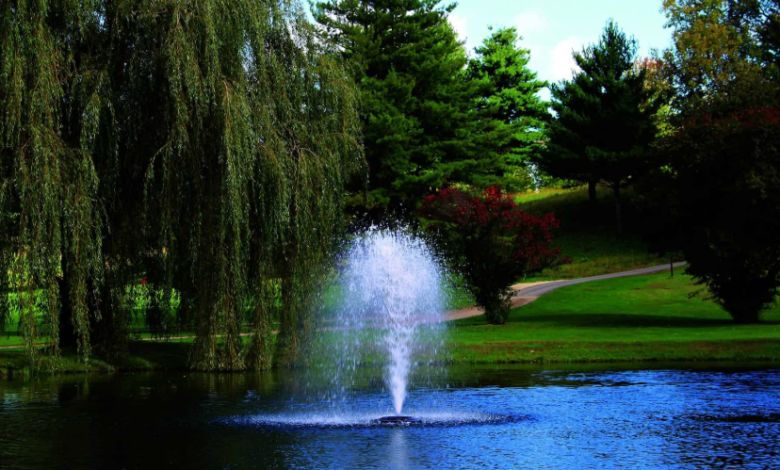The Breath of Your Pond: How Fountains Are Essential for Water Health and Aeration

Stagnant pond water creates a breeding ground for problems that can quickly transform your beautiful water feature into an eyesore. Without proper circulation and oxygen exchange, your pond becomes vulnerable to algae blooms, foul odors, and declining water quality that threatens aquatic life.
Pond fountains serve as more than decorative centerpieces – they function as vital life support systems for your water feature. The continuous water movement and spray patterns create essential aeration that introduces oxygen directly into your pond ecosystem, supporting healthier water conditions year-round.
Understanding the Science Behind Pond Aeration
Oxygen Transfer Through Water Movement: The fundamental principle behind fountain aeration involves maximizing the water’s surface contact with air. As water droplets cascade through the air and splash back into the pond, they absorb dissolved oxygen that becomes available to beneficial bacteria and aquatic organisms throughout your water feature.
Natural Gas Exchange Process: Fountains facilitate the release of harmful gases like carbon dioxide and hydrogen sulfide that accumulate in stagnant water. This gas exchange prevents the buildup of toxic compounds that can create anaerobic conditions, leading to fish kills and unpleasant sulfur odors in your pond environment.
Dissolved Oxygen Distribution: The turbulent mixing action created by fountain operation helps distribute oxygen-rich water to deeper pond layers. This vertical circulation prevents the formation of dead zones where oxygen-depleted water would otherwise settle, creating inhospitable conditions for beneficial organisms that maintain water quality balance.
Water Quality Benefits From Fountain Aeration
Algae Growth Prevention: Proper aeration disrupts the conditions that allow algae to flourish in your pond. Moving, oxygenated water prevents the stratification that creates nutrient-rich layers where algae thrive. The constant circulation distributes nutrients evenly, reducing concentrated pockets that fuel excessive algae development.
Beneficial Bacteria Support: Aerobic bacteria require oxygen to break down organic waste, decomposing leaves, fish waste, and other debris that would otherwise accumulate on your pond bottom. These helpful microorganisms can only function effectively when sufficient dissolved oxygen levels are maintained through consistent fountain operation.
Temperature Regulation: Fountain spray patterns help prevent thermal stratification in deeper ponds, where warmer surface water sits above cooler bottom layers. This mixing action maintains more consistent temperatures throughout the water column, creating better conditions for fish and preventing the formation of oxygen-depleted zones.
Nutrient Cycling Enhancement: The increased biological activity from improved oxygenation accelerates the natural breakdown of organic matter. This enhanced decomposition process prevents the accumulation of muck and sediment that would otherwise reduce your pond’s depth and create anaerobic pockets harmful to water quality.
See also: 3 Smart Cleaning Tech for a Maintained & Pristine Home
Mosquito Control Through Water Movement
Disrupting Breeding Cycles: Mosquitoes require still water surfaces to lay their eggs successfully. The constant surface agitation created by fountain operation makes it nearly impossible for mosquitoes to complete their reproductive cycle in your pond. Even small fountains can provide enough movement to deter these unwanted pests effectively.
Eliminating Stagnant Zones: Areas of your pond that remain motionless become prime breeding spots for mosquitoes and other insects. Strategic fountain placement ensures water circulation reaches all corners of your pond, eliminating the stagnant pockets where mosquito larvae would typically develop and mature.
Surface Film Disruption: Many flying insects rely on surface tension to land and deposit eggs on water surfaces. The continuous rippling effect from fountain spray breaks this surface film, making it difficult for pests to establish contact with the water and complete their reproductive processes.
Supporting Aquatic Ecosystem Health
Fish Welfare Improvement: Fish species common in backyard ponds require adequate dissolved oxygen levels to maintain their health and vitality. Poor oxygenation leads to stressed fish that become susceptible to disease, reduced feeding activity, and potentially fatal conditions during hot summer months when oxygen levels naturally decline.
Plant Life Balance: Aquatic plants benefit from the improved water circulation that fountains provide, though the relationship requires careful balance. Submerged plants produce oxygen during daylight hours but consume it at night. Fountain aeration helps maintain stable oxygen levels during these nighttime periods when plants aren’t contributing to the oxygen supply.
Beneficial Microorganism Growth: The enhanced oxygen levels support populations of beneficial microorganisms that form the foundation of a healthy pond ecosystem. These microscopic helpers process waste products, compete with harmful bacteria for resources, and contribute to the overall biological balance necessary for long-term pond health.
Winter Aeration Benefits: Operating fountains during colder months prevents complete surface freezing that can trap harmful gases under ice. This winter circulation maintains minimal gas exchange, preventing toxic buildup that could harm fish populations when temperatures begin rising in spring months.
Practical Fountain Selection Considerations
Choosing the right fountain involves understanding your pond’s specific aeration needs based on size, depth, and fish population. Different fountain styles provide varying levels of aeration effectiveness:
- Spray patterns with fine droplets: Create maximum surface area for oxygen absorption
- High-volume pumps: Move larger amounts of water for comprehensive circulation
- Multiple outlet designs: Distribute aeration across wider pond areas
- Adjustable flow rates: Allow seasonal optimization for changing oxygen demands
Sizing for Maximum Benefit: Your fountain’s pump capacity should match your pond volume and depth requirements. Shallow ponds need different circulation patterns than deeper water features. Consider factors like fish density, organic load from plants and debris, and seasonal temperature variations when selecting appropriate fountain specifications.
Energy Efficiency Considerations: Modern fountain pumps offer variable speed controls that allow you to adjust aeration levels based on seasonal needs. Running fountains at reduced speeds during cooler months saves energy while maintaining adequate circulation for gas exchange and preventing stagnation problems.
Conclusion
Your pond’s health depends on maintaining adequate oxygen levels and proper water circulation that only consistent fountain operation can provide. The investment in quality fountain equipment pays dividends through reduced maintenance, healthier fish populations, and a more attractive water feature that enhances your outdoor space. Take action today to give your pond the aeration it needs for long-term success and enjoyment.







